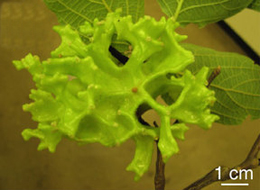Research Abstract
閉鎖系で社会生活を維持するために昆虫が誘導する植物の新規表現型
An insect-induced novel plant phenotype for sustaining social life in a closed system
2012年11月13日 Nature Communications 3 : 1187 doi: 10.1038/ncomms2187

採餌、防衛、そして排泄物処理は、社会性昆虫がコロニーを維持していくのに不可欠である。そのため、こうした昆虫の巣は概して開放構造をしており、そこではワーカーや兵隊と呼ばれる専門化したカーストがこのような仕事を担当する。しかし、一部の社会性アブラムシは完全閉鎖型の虫こぶを形成し、数百から数千個体が数か月間にわたりその中に隔離された状態で成長、繁殖する。このような社会性アブラムシが、なぜ液体排泄物の蓄積によって溺れ死ぬことがないのかは謎であった。今回我々は、閉鎖系における排泄物処理という問題に対する巧妙な生物学的解決法について報告する。このような閉鎖型の虫こぶの内表面は水を吸収するように特殊化し、アブラムシの液体排泄物は植物の維管束系を介して速やかに除去されるのである。水を吸収する閉鎖型の虫こぶは、社会性アブラムシにおいて少なくとも独立に2回進化してきた。このような植物による排泄物除去は、植物の形態形成および生理状態を昆虫が操作するという、従来知られていなかった巣の清掃機構であり、社会性アブラムシの「延長された表現型」および「間接的な社会行動」と見なすことができる。
- 独立行政法人 産業技術総合研究所(AIST)生物プロセス研究部門
- 京都大学 生態学研究センター
- 放送大学 教養学部
- 東京大学 広域システム科学系
Foraging, defense and waste disposal are essential for sustaining social insect colonies. Hence, their nest generally has an open structure, wherein specialized castes called workers and soldiers perform these tasks. However, some social aphids form completely closed galls, wherein hundreds to thousands of insects grow and reproduce for several months in isolation. Why these social aphids are not drowned by accumulated honeydew has been an enigma. Here we report a sophisticated biological solution to the waste problem in the closed system: the gall inner surface is specialized for absorbing water, whereby honeydew is promptly removed via the plant vascular system. The water-absorbing closed galls have evolved at least twice independently among social aphids. The plant-mediated waste removal, which entails insect’s manipulation of plant morphogenesis and physiology, comprises a previously unknown mechanism of nest cleaning, which can be regarded as ‘extended phenotype’ and ‘indirect social behavior’ of the social aphids.

